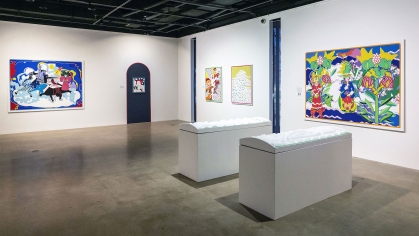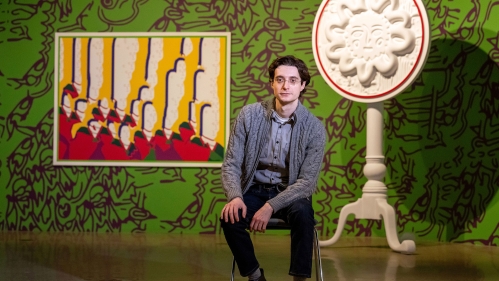The 18 pieces in Rutgers University–Camden professor Stass Shpanin’s latest public art exhibition, Portals, reimagine American history in ways that may leave visitors with more questions than answers. The effect is intentional, as Shpanin, an assistant teaching professor and program director in the Department of Visual, Media, and Performing Arts (VMPA), has used regional imagery to question notions of nature, mythology, and the evolution of Americana.
Portals was in development for three years, as Shpanin studied and developed work inspired by folk-art drawings called “fraktur.” Dating back to the 18th and 19th centuries, these pieces include elaborate depictions of birds, flowers, hearts, unicorns, and more. Immigrants from Switzerland, Germany, and France were known to have created fraktur imagery to commemorate important events.

Blending old and new, Shpanin imbues his work with AI-generated imagery. He inputs original elements into Photoshop, where he has plugins continue drawing. “I could be deleting certain elements, asking it to regenerate again, redrawing on top—it becomes almost a visual conversation,” he said. In several of his pieces, intricate, repeating patterns may have received AI-augmented treatments.
Shpanin grew interested in history while studying art at the University of Hartford. His first subject was the entrepreneur and gun manufacturer Samuel Colt. “To me, he embodied ideas of violence and entertainment,” he said, referencing Colt’s endeavors selling fireworks and laughing gas. Shpanin leveraged these juxtaposing elements into a theme-park-like exhibit with a merry-go-round and immersive paintings with cutouts for visitors to place their heads inside.
Shpanin built his portfolio with both international and local exhibits before embarking on the Portals project at the Phillips Museum of Art in Lancaster, PA.

Shpanin immerses his students in his professional work and, with Portals, gave them an inside look into the process. He showed his students a 3D model he developed of the space and walked through the decisions he made when planning for the exhibit. “I brought some of the students to my studio,” he said. “Sometimes I hire students as well, so they see the process in many directions.”
As program director for the VMPA at Rutgers–Camden, Shpanin has played a critical role in shaping the school’s arts outreach and programming. He runs a pre-college arts session; the Saturday classes include animation, graphic design, acting, music, technology, and production. He collaborated with Allan Espiritu, professor of art, on the launch of the department’s bachelor of fine arts program. Behind the scenes, Shpanin supervises a small team responsible for marketing the exhibitions, concerts, and theater productions offered by the VMPA.

Shpanin will continue his work with Portals, though its stay at the Phillips ends April 25. There are plans create an exhibition catalog, which will be partially funded through a grant by the Rutgers University–Camden Office of Research. The publication will include production images along with contributing essays by a curator and an art critic. Shpanin sees himself showcasing this work again in another museum venue.
“This is the largest exhibition that I have had so far, and I would like to continue working with museums, because I'm interested in working with the site-specific installations and collections that they have,” Shpanin said. “That's a very important step for me as an artist.”



